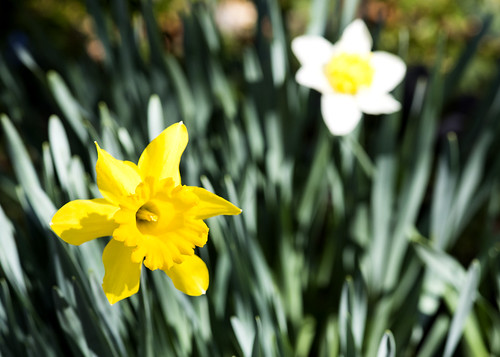Joy and sorrow when plants bloom early
By Fred Miller
U of A System Division of Agriculture
Feb. 28, 2017
Fast Facts:
- Unseasonably warm weather has prompted many flowers to bloom 2-3 weeks earlier than typical.
- Blooming plants are at risk of damage from cold snaps.
(479 words)
(Newsrooms with art at: https://flic.kr/s/aHskPzevJN and related web page at https://www.uaex.uada.edu/yard-garden/default.aspx)
FAYETTEVILLE, Ark. — Wait … what month is this?
The calendar may still say winter, but unseasonably warm temperatures have convinced many blooming plants that spring has arrived. Color is popping out all over the place.
On the ground and in the trees, profusions of whites, reds, yellows — lots of yellows — blues and other spring shades are making a winter appearance.
“Flowering plants are three or four weeks ahead of schedule here,” said Janet Carson, extension horticulture specialist for the University of Arkansas System Division of Agriculture.
Garry McDonald, assistant professor of horticulture, said the blooms are two to three weeks early in northwest Arkansas. And Dan Chapman, director of the division’s Fruit Research Station, said peach trees are blooming now when mid-March is more typical.
McDonald said early blooming flowers can raise people’s spirits. “It kind of gives you hope that winter’s coming to an end,” he said.
Early blooming plants are top-sellers at nurseries, McDonald said, because people want that psychological boost of color after a long winter.
The flowers that bloom as early as they have this year seem more brilliant, McDonald said. “Maybe it’s because there hasn’t been any color over the winter, or maybe it’s because their colors really pop when they’re not surrounded by bright green grass.”
A downside of early blooms, McDonald said, is that they finish early. “So, now we won’t have those flowers when we normally expect them.”
And then there’s the erratic nature of Arkansas weather. It may be nice to have all this color in February, but early blooming puts flowering plants at risk of freeze damage when winter reasserts itself.
Carson’s advice: “Enjoy it as long as it lasts, and if it freezes, we’ll deal with it.”
Dormancy is how plants endure winter cold, Carson said. But when unseasonably warm weather causes plants to bloom early, a cold snap can bring them to an early end.
Most of the plants will probably survive a dip to just below freezing, McDonald said. But once the temps dip to 27 degrees Fahrenheit or lower, flowers turn to “dishrags on a stick.”
“Plants are a lot less winter hardy when they’re actively growing,” Carson said.
The degree of damage is determined by how cold it gets and how long it stays cold, McDonald said. Other factors, like wind, may help protect plants when air temperature plummets.
“Wind stirs the air, mixing the air with residual heat out of the ground,” McDonald said. “It can moderate the air temperature and protect plants.”
Carson said gardeners and homeowners can take some precautions when temperatures are forecast to drop. She recommends covering plants before temperatures drop. Cardboard boxes or pots can be turned over to cover small plants, and sheets can cover larger flowerbeds or small shrubs.
More helpful information can be found on the Arkansas Cooperative Extensions Service’s Yard and Garden page: https://www.uaex.uada.edu/yard-garden/default.aspx.
Pursuant to 7 CFR § 15.3, the University of Arkansas System Division of Agriculture offers all its Extension and Research programs and services (including employment) without regard to race, color, sex, national origin, religion, age, disability, marital or veteran status, genetic information, sexual preference, pregnancy or any other legally protected status, and is an equal opportunity institution.
# # #
By Mary Hightower
The Cooperative Extension Service
U of A System Division of Agriculture
Media Contact: Mary Hightower
Dir. of Communication Services
U of A Division of Agriculture
Cooperative Extension Service
(501) 671-2126
mhightower@uada.edu
Related Links
